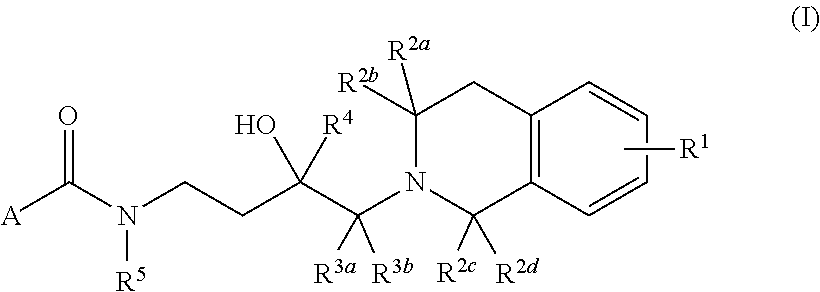Tetrahydroisoquinoline derived prmt5-inhibitors
a technology of tetrahydroisoquinoline and inhibitors, which is applied in the field of tetrahydroisoquinoline derived prmt5 inhibitors, can solve the problems of elusive mechanisms, and achieve the effects of reducing arginine-methylated p53, synergizing well, and modulating p53 activity
- Summary
- Abstract
- Description
- Claims
- Application Information
AI Technical Summary
Benefits of technology
Problems solved by technology
Method used
Image
Examples
example 1
4-Chloro-N-(4-(3,4-dihydroisoquinolin-2(1H)-yl)-3-hydroxybutyl)benzamide (1)
[0419]
[0420](a) 2-(But-3-en-1-yl)isoindoline-1,3-dione (A1)
[0421]Potassium phthalimide (500 mg, 2.70 mmol), acetonitrile (5 mL) and 4-bromobut-1-ene (0.548 mL, 5.40 mmol) were stirred at 90° C. After 18 hours, the mixture was cooled to room temperature, filtered and the collected solids were washed with ethyl acetate (5 mL). The combined filtrates were concentrated and column chromatography (12 g SiO2 cartridge, 0-100% ethyl acetate in petroleum benzine 40-60° C.) gave the desired compound as a white solid (431 mg, 79%). 1H NMR (400 MHz, CDCl3) δ 7.87-7.80 (m, 2H), 7.73-7.67 (m, 2H), 5.86-5.72 (m, 1H), 5.11-4.99 (m, 2H), 3.77 (t, J=7.1 Hz, 2H), 2.49-2.40 (m, 2H). LCMS-B RT 3.71 min; m / z 202.1 [M+H]+.
[0422](b) 2-(2-(Oxiran-2-yl)ethyl)isoindoline-1,3-dione (A2)
[0423]2-(But-3-en-1-yl)isoindoline-1,3-dione A1 (428 mg, 2.13 mmol), chloroform (5 mL) and 70-75% m-CPBA (629 mg, 2.55 mmol) were stirred at room temper...
example 2
[0466]General Procedure A
[0467]To lithium 4-((4-(3,4-dihydroisoquinolin-2(1 H)-yl)-3-hydroxybutyl)carbamoyl)benzoate I2 (70 mg, 0.19 mmol, 1 equiv) in CH3CN (2 mL) was added DIPEA (130 μL, 0.75 mmol, 4 equiv) and HATU (107 mg, 0.281 mmol, 1.5 equiv). The desired amine (0.561 mmol, 3 equiv) in DMF (1 mL) was added and the reaction stirred at room temperature for 16 h. The reactions were quenched by the addition of a 1M aqueous solution of NaOH (2 mL) and stirred for 1 h. DCM (3 mL) was added, the layers mixed thoroughly and then passed through a phase separation cartridge (3mL). The aqueous layer was further extracted with DCM utilising the phase separation cartridge (2×3 mL). The combined organic layers were concentrated by a stream of air. An equivalent volume of MeOH was added and the solution purified by solid-phase extraction (1 g SCX-2 cartridge, 3 column volumes of methanol followed by 3 column volumes of 0.2 M methanolic ammonia). The organic solvent was removed in vacuo to g...
example 3
2-Chloro-N-(4-(3,4-dihydroisoquinolin-2(1H)-yl)-3-hydroxybutyl)isonicotinamide 44
[0474]
[0475]To 2-chloroisonicotinic acid (0.23 mmol, 1 equiv) in CH3CN (2 mL) was added DIPEA (120 μL, 0.69 mmol, 3 equiv) and HATU (131 mg, 0.345 mmol, 1.5 equiv). 4-amino-1-(3,4-dihydroisoquinolin-2(1H)-yl)butan-2-ol A4 (51 mg, 0.23 mmol, 1 equiv) in DMF (1 mL) was added and the reaction stirred at room temperature for 16 h. The reaction was quenched by the addition of a 1M aqueous solution of NaOH (2 mL) and then stirred for 3 h. The reaction was extracted with DCM (3×3 mL) utilising a phase separation cartridge and the combined organic layers reduced under a stream of air. An equivalent volume of MeOH was added and the solution purified by solid-phase extraction (1 g SCX-2 cartridge, 3 column volumes of methanol followed by 3 column volumes of 0.2 M methanolic ammonia). The organic solvent was removed in vacuo and the residue was purified by column chromatography (12 g, 50-100% EtOAc (modified by th...
PUM
| Property | Measurement | Unit |
|---|---|---|
| particle size | aaaaa | aaaaa |
| concentration | aaaaa | aaaaa |
| concentration | aaaaa | aaaaa |
Abstract
Description
Claims
Application Information
 Login to View More
Login to View More - R&D
- Intellectual Property
- Life Sciences
- Materials
- Tech Scout
- Unparalleled Data Quality
- Higher Quality Content
- 60% Fewer Hallucinations
Browse by: Latest US Patents, China's latest patents, Technical Efficacy Thesaurus, Application Domain, Technology Topic, Popular Technical Reports.
© 2025 PatSnap. All rights reserved.Legal|Privacy policy|Modern Slavery Act Transparency Statement|Sitemap|About US| Contact US: help@patsnap.com



